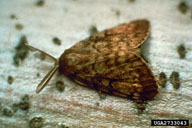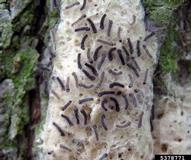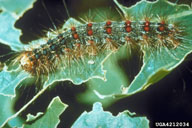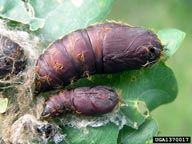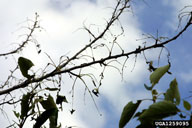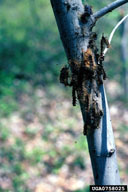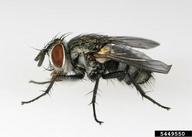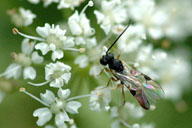European gypsy moth
Lymantria dispar (L.) (Lepidoptera: Lymantriidae)
Orientation to pest
European gypsy moth, Lymantria dispar (L.), is an invasive species in the United States that has been a major forest pest for over a century. Its damage consists of defoliation of deciduous forests and trees in spring and early summer. Efforts to control this species with introduced natural enemies began around 1900 and currently it is under good control in New England, but outbreaks still occur to the west and south, where the pest continues to invade. There is one generation a year and the species overwinters as eggs on trees or various objects. Spread occurs locally by wind-blown young caterpillars and over long distances by human movement of egg masses. Female moths cannot fly. Both adults and caterpillars are easily recognized (see photos below).
Hosts commonly attacked
The larvae of this species feed on most species of deciduous trees, especially oaks (Quercus).
Distribution
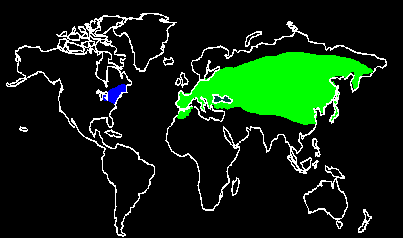 USDA Forest Service - Northeastern Research Station "Gypsy Moth in North America" USDA Forest Service - Northeastern Research Station "Gypsy Moth in North America" |
| Figure 1. World distribution of European gypsy moth. |
Images of European gypsy moth
| Figure 2. Female European gypsy moth, Lymantria dispar, (on egg mass); note white wings with brown zigzag lines | Figure 3. Male European gypsy moth; note brown wings and feather-like antennae | Figure 4. Newly hatched caterpillars of European gypsy moth on egg mass, preparing to disperse by crawling or blowing in the wind on silk threads |
| Figure 5. Mature European gypsy moth caterpillar; note series of blue or red spots on back, plus clusters of hairs on sides | Figure 6. Pupae of European gypsy moth in silken cradle (far left). Threads cut away to show detail. Female pupa above, male below. | Figure 7. Defoliation from European gypsy moth |
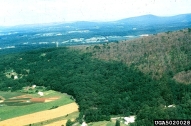 Pennsylvania Department of Conservation and Natural Resources - Forestry Archive, Bugwood.org 768x512 Pennsylvania Department of Conservation and Natural Resources - Forestry Archive, Bugwood.org 768x512 |
|||
| Figure 8. Aerial view of defoliation from European gypsy moth. In the absence of effective biological control, widespread defoliation of forest stands can occur in late spring. Defoliation areas appear brown, on the upper slope. | Figure 9. The nucleopolyhedrosis virus of European gypsy moth can cause epidemics in dense European gypsy moth populations but comes too late to prevent damage. Virus-killed caterpillars hang by their legs on tree and fluids from rotting cadavers drip onto foliage, spreading virus. | ||
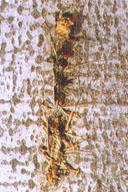 Andy Liebhold - USDA Forest Service - Northeastern Research Station "Gypsy Moth in North America" 302x298 Andy Liebhold - USDA Forest Service - Northeastern Research Station "Gypsy Moth in North America" 302x298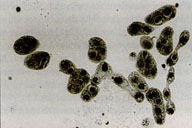 Andy Liebhold - USDA Forest Service - Northeastern Research Station "Gypsy Moth in North America" 405x328 Andy Liebhold - USDA Forest Service - Northeastern Research Station "Gypsy Moth in North America" 405x328 |
|||
| Figure 10. The fungus Entomophthora maimaiga has emerged as a key biological control agent of European gypsy moth in the northeastern United States (left photo, diseased caterpillar; right photo, fungal protoplasts) | Figure 11. Compsilura concinnata an important tachinid parasitoid of the European gypsy moth | Figure 12. Cotesia melanoscela: a parasitoid of European gypsy moth larvae | |
Important biological control agents related to this pest species
Of some 80 species of parasitoids imported and released into the United States against this pest, 11 species became established and six are believed to have contributed to control of the European gypsy moth: (1) Ooencyrtus kuvanae (Howard) (Hymenoptera: Encrytidae), (2) Cotesia melanoscela (Ratzeburg) (Hymenoptera: Braconidae), (3) Brachymeria intermedia (Nees) (Hymenoptera: Chalcididae), (4) Compsilura concinnata (Meigen) (Diptera: Tachinidae), (5) Parasetigena silvestris (Robineau-Desvoidy) (Diptera: Tachinidae), and (6) Blepharipa pratensis (Meigen) (Diptera: Tachinidae). Effective control was achieved in the northeastern United States following the accidental introduction of the fungal pathogen Entomophthora maimaiga Humber, Shimazu, and Soper.
Web links for information on European gypsy moth
- Gypsy Moth In North America |
Northeastern Research Station, USDA Forest Service
Provides information and links to other sites on a variety of topics - Forest Insect & Disease Leaflet 162 | USDA Forest Service
Articles
- Hajek, A. E., J. S. Elkinton, J. J. Witcosky. 1996. Introduction and spread of the fungal pathogen Entomophaga maimaiga (Zygomycetes: Entomophthorales) along the leading edge of gypsy moth (Lepidoptera: Lymantriidae) spread. Environmental Entomology 25: 1235-1247.
- Liebhold, A., J. Elkinton, D. Williams, and R. M. Muzika, R. M. 2000. What causes outbreaks of the gypsy moth in North America? Population Ecology 42: 257-266
- Elkinton, J. S., W. M. Healy, A. M. Liebhold, A. M., and J. P. Buonaccorsi. 2002. Gypsy moths and forest dynamics, pp. 100-112. In: McShea, W. J. and W. M.Healy. Oak Forest Ecosystems: Ecology and Management for Wildlife. John Hopkins University Press. Baltimore, MD, USA

